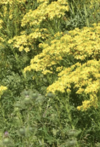Lumps & Poisoning of Farm Animals Flashcards
what are the differences in neoplasia with SA/equine and farm animals
Farm animals don’t live long enough to develop ‘old age’ neoplasia
Juvenile neoplasia observed
Diagnostics beyond US scan and FNA biopsy performed (no staging)
Chemo/radio never an option (surgical excision considered)
Cattle —> notifiable neoplasia
what are the ddx to lumps
Tumour
Seroma
Hematoma
Abscess
Lymph node
how do you US scan lumps
Rectal probe on early/late preg setting
Clip hair
Apply warm water/spirit + US gel
Moderate pressure with probe
what appears hypoechoic on US
black
fluid (seroma/hematoma)
what appears hyperechoic on US
White (hyperechoic) = mass
what has mixed echogenicity
Black/white (mixed echogenicity) = abscess/organizing seroma or hematoma
how do you FNA a lump
Clip + scrub
At least 18g (pink) needle, might need thicker
Feel consistency as insert needle
Might need to apply pressure with syringe
what does blood, clear fluid and pus mean from an FNA
Blood = hematoma
Clear fluid = seroma
Pus = abscess
Nothing = thick pus, tumour, LN or something else
Prepare slide for cytology if needed
how do you treat a tumour
Report to APHA?
Leave or surgical resection (margins, space, ££)
how do you treat a seroma
leave
how do you treat a hematoma
leave
how do you treat an abscess
lance (think about where)
flush (Water +/- disinfectant for approx 3 days)
aim to keep open
+/- antibiotics
how do you treat a lymph node lump
Cause?
Treat primary lesion
what are the ddx for ill thrift adult cow

what are ddx for lumps in cows
- sporadic bovine leukosis (SBL)
- enzootic bovine leukosis (EBL)
- squamous cell carcinoma
- papilloma
- granulosa cell tumour
- cutaneous actinobacilosis
- OPA sheep
- melanomas
- GIT carcinomas
- lymposarcoma sheep
- cutaneous lymphoma
- bladder tumours: bracken induced, hematuria
what age does sporadic bovine leukosis (SBL) occur in
youngish animals <4 years
what are the 3 forms of sporadic bovine leukosis (SBL)
- cutaneous
- thymic
- mutlicentric (lymphosarcoma) aka juvenile
what is the thymic form of sporadic bovine leukosis (SBL) cause
space occupying lesion (SOL) effects
jugular occluded
RR increased
bloat
what does the multicentric form of sporadic bovine leukosis (SBL) cause
Multiple lymph nodes (LN) enlarged
how is sporadic bovine leukosis (SBL) treated
no treatment
poor prognosis
is enzootic bovine leukosis (EBL) notifiable
yes
what are the causes of enzootic bovine leukosis (EBL)
Bovine leukemia virus = oncogenic retrovirus
at what age is enzootic bovine leukosis (EBL) infectious
Signs in adult animals (>2 years, generally >4)
what are the signs of enzootic bovine leukosis (EBL)
Mostly sub-clinical:
0.1-10% develop tumours
30-70% lymphocytosis
Clinical signs:
Variable and multiple depending on where tumour is
Weight loss
Milk drop
Lymphadenopathy
Neurological signs
Often subclinical
what are the clinical signs of enzootic bovine leukosis (EBL)
Variable and multiple depending on where tumour is
Weight loss
Milk drop
Lymphadenopathy
Neurological signs
Often subclinical
what is the transmission of enzootic bovine leukosis (EBL)
horizontal
what is the age of enzootic bovine leukosis (EBL) infected on average
>4 years
what type of cattle does enzootic bovine leukosis (EBL) infect
dairy
what is the clinical appearance of enzootic bovine leukosis (EBL)
multicentric
what is the incidence of enzootic bovine leukosis (EBL)
multiple
what is the etiology of sporadic bovine leukosis
unknown
what is the transmission of sporadic bovine leukosis
unknown
what is the age of sporadic bovine leukosis infected
<4 years
what type of cattle does sporadic bovine leukosis infect
dairy and beef
what is the clinical appearance of sporadic bovine leukosis
multicentric
thymic
skin















